Educating Juveniles in Prison Unlocks Opportunity
Rumor has it that determination of prison capacity is decided on the basis of third-grade reading scores. According to reports, this claim is purely hearsay. However, the believed credibility of this statement creates some pause as to the connection between education levels and incarceration rates.
A study conducted by The Quarterly Journal of Economics observed that adolescent incarceration decreases high school graduation rates by upward of 13 percent compared to the average non-incarcerated juvenile. Not only does it affect the likelihood of obtaining a GED, but it also increases the chances of incarceration as an adult from anywhere between 23-41 percent.
As the previously mentioned study found, the benefits of juvenile incarceration for certain offenders have not been proven to outweigh the costs. This is because individuals’ human capital diminishes and future crime is not deterred. Aggregation of human capital is best defined as high school completion and recidivism in adulthood. As education is a way to build one’s human capital, not providing a juvenile with it will hinder success in the job market. During the juvenile period of an offenders’ life, human capital is still in its developmental stages; so therefore the longitudinal effects of impeded educational opportunities are greater.
Human capital has the opportunity to flourish if this issue is properly addressed. In order to effectively improve the current juvenile justice education system, advancements must be made by individually addressing non-violent and violent juveniles.
For non-violent juveniles, at times with sentences as little as 1-2 months, incarceration is more of a deterrent to educational success rather than crime. As an alternative to incarceration, mentorship programs would be more successful in deterring criminal activity for non-violent juveniles. Big Brothers Big Sisters (BBBSA) is an exemplary program that advocates for the success of youths struggling with community adversity. This program is an effective deterrent to crime because youth’s are held accountable by their mentor to attend school. BBBSA’s success is measured based on a number of factors, including parental trust, attitudes towards risky behaviors, grades, educational expectations, confidence in doing schoolwork, sense of belonging among peers and presence of a special adult. In order for mentorship programs to achieve utmost success in these areas, there must be regular interaction between the mentor and the juvenile as well as a maintained partnership long term. Mentorship programs, such as BBBSA, grant the opportunity for non-violent youths to correct behavior and to continue community education without imprisonment.
By contrast, juveniles convicted of violent offenses should be incarcerated for a period of time to promote public safety; in addition to being provided with structured opportunities to continue education during their sentence. Education within prisons should be geared towards a purposeful learning structure as well as towards successful re-entry following incarceration.
For these violent offenders, a structured educational environment can promote long-term success. Interviews and classroom observations, conducted within a study by the National Criminal Justice Reference Service (NCJRS), found that success is bound to a positive environment, effective classroom methods, transition and recidivism prevention. In addition to improving education methods within prisons, it is also imperative to effectively transition adolescents’ either back into society or back into community schools. The study additionally found that re-integration is most successful through the implementation of “family and community-based strategies as well as restorative justice programs.” One teacher in the NCJRS study reported, “I am really helping kids just get excited about education and that’s the starting point.” This is the goal; to promote juveniles excitement for education, rather than crime.
This month, Curtis Brooks was released from prison after serving his time for 22 years. Brooks, sentenced to life for first degree murder at age 15, was miraculously transformed by educational opportunities in prison. “Prison helped me realize who I didn’t want to be,” Brooks stated. For him the transformation came over time, as philosopher Descarte’s “I think therefore I am” became a motto that fueled his modification. Brooks currently has a job lined up with Prince George’s County in Maryland. As a result of educational opportunity in prison, Brooks is a walking example of the way that education programs in juvenile facilities can rehabilitate offenders.
Whether the youth is a non-violent or violent offender, education serves as a crucial aspect of a juvenile’s development into a successful American citizen. The promotion of mentorship programs, as an alternative to incarceration for non-violent juveniles, and the implementation of structured classrooms during incarceration for violent juveniles, will provide hopeful opportunities for these juveniles’ futures.
Rehabilitative efforts for juveniles should be shifted to primarily focus on education, as it is a facet that decreases the likelihood of recidivism in adulthood. The juvenile justice system can build up human capital, rather than waste it. Let’s unleash that potential by advocating for structured and positive education environments within facilities as well as for improved re-integration efforts within community education after incarceration.

